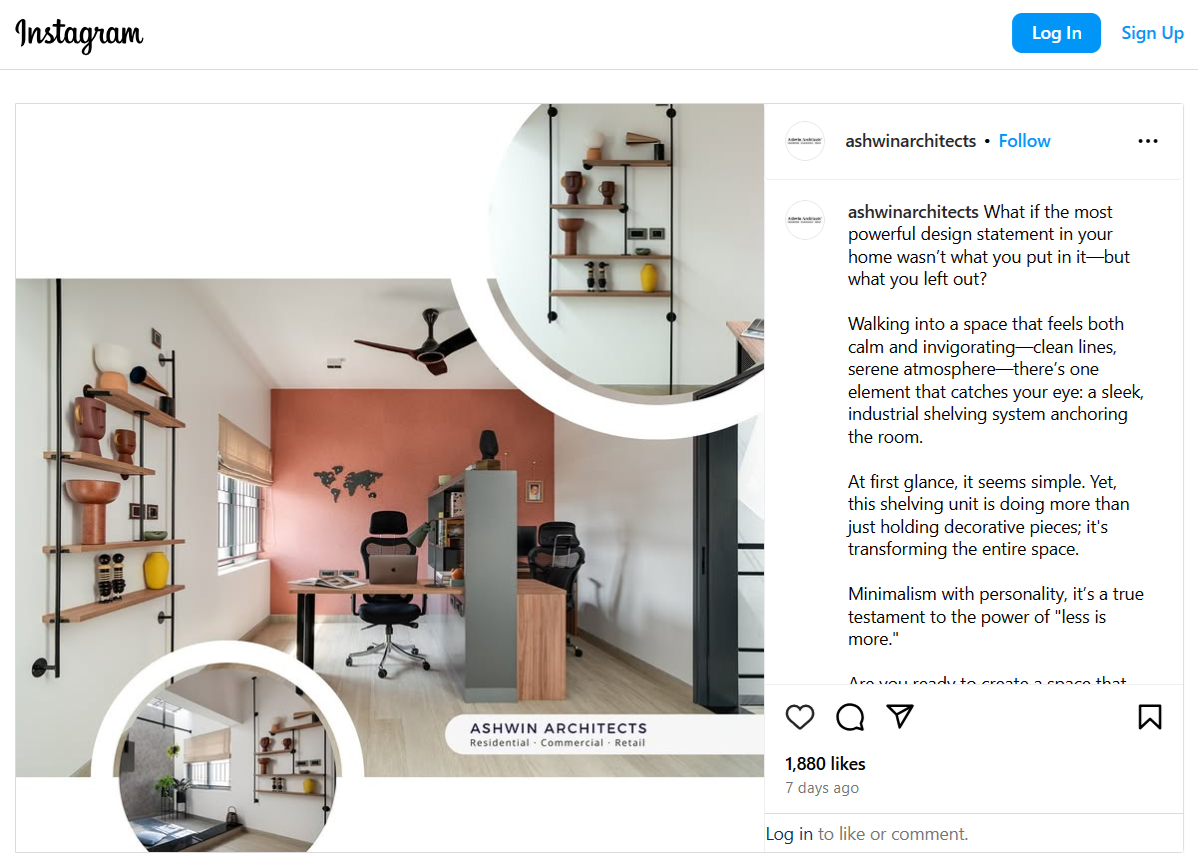5 Proven tips to designing lead generating website for architects and interior design firms

Whether you specialize in sustainable design or have a knack for crafting luxurious homes, how you present your expertise on your website can make all the difference. Positioning your firm effectively is the base to a rock solid lead generating website for architects (and interior design firms). After all, this digital front attracts clients who truly appreciate what you bring to the table and converts them into valuable inquiries.
Lead generation for architects.
Discover strategies for lead generation for architects, with a focus on one proven approach: well-optimized website.
We’re going to dive deep into creating a website stands out in the sea of architecture websites such that will bring about lead generation for architects. To begin with, we’ll talk about how to make your firm’s unique selling points shine bright. You know what sets you apart – let’s make sure everyone else does too. After which, we’ll explore the art of designing a digital space that’s both a feast for the eyes and a magnet for high quality architect leads.
1. Expertise driven website for lead generation
Imagine this: your firm becomes the go-to expert in a specific area of architecture, like sustainable design or luxurious residences. By focusing on this niche, you build a unique identity that attracts clients who are actively seeking your specialized skills. From the very beginning, customers will see that their needs are at the center of everything you do. When you show that you’re all about truly understanding and meeting their expectations, it’s clear that you’re not just designing buildings—you’re creating personalized experiences. Your commitment to collaborating and exceeding expectations will strike a chord with homeowners who want a partner who listens and delivers.
Let’s talk about innovation. Make sure to highlight how your firm stays at the forefront of the industry, whether it’s through the latest materials, advanced design software, or sustainable practices. This approach not only positions your firm as a leader but also attracts design seekers who are looking for forward-thinking solutions. Think about who your dream clients are—are they luxury homeowners or environmentally conscious businesses? Tailor your website’s content and messaging to speak directly to their needs. For instance, if you’re targeting end users who are socially conscious, demonstrate how you incorporate cultural and environmental considerations into your designs. This is one of the effective strategies to generate leads for architecture firms. It will also help position your firm as one that respects and integrates local culture and history.
And don’t forget to highlight if your firm has international experience but also understands local contexts and regulations. Clients will appreciate knowing that you offer a global perspective while navigating the unique challenges of their specific location.
Real use case to get leads for architects: Sustainable.TO, based in Toronto creates beautiful, healthy, high-performance buildings that reduce carbon emissions and promote positive environmental change. Their website highlights detailed case studies of eco-friendly projects and their commitment to community-driven design. By showcasing these aspects, they position themselves as experts in sustainable architecture. Their approach not only educates visitors on the benefits of sustainable design but also attracts clients who share these values.
2. Standout websites customized to architecture lead generation
If you want your website to truly stand out and reflect your professional practice, start with personalization. Think of your site as a direct extension of your brand and design philosophy—something that sets you apart from general platforms like Houzz or Architectural Digest. Adding interactive features, like design preference quizzes or custom project showcases that adapt based on user input, can make the experience more engaging and unique to each visitor.
Exclusive content is another way to make your site memorable. Imagine offering visitors access to detailed case studies, behind-the-scenes looks at your projects, or insightful thought leadership pieces. This kind of content not only differentiates your site but also positions you as an authority in your field. While other sites might provide broad inspiration, your website is the place where you can dive deep into your work and showcase your expertise.
When it comes to navigation, keep things simple and elegant. Architect’s website should be easy to get around, so focus clearly on presenting your services, portfolio, and contact information. Avoid clutter and distractions to ensure a seamless experience for your visitors. And, considering today’s emphasis on sustainability, make sure to highlight your commitment to green building practices. It’s about showing that you not only look good but are also doing good.
Finally, offer direct ways for potential leads to get in touch with you. Whether it’s through a live chat feature, the ability to book a consultation, or a client portal for project updates, make it easy for them to connect and engage. Plus, don’t shy away from showcasing customer testimonials and any awards or recognitions you’ve received. Displaying this kind of credibility can help build trust. And for your blog or insights section, tailor the content to speak directly to your expertise—think tips on sustainable design for homeowners or strategies for optimizing commercial spaces.
3. Differentiate from the competition
To really make a mark and set yourself apart from the competition, start by highlighting your signature design style. Think of it as your firm’s unique visual fingerprint—something that makes your work instantly recognizable. Whether it’s a distinctive design philosophy or a specific aesthetic, this signature style should be front and center in your marketing efforts. It’s what makes your work special and memorable, so don’t be shy about showcasing it proudly. After all it’s one of the best architectural lead generation strategies.
Incorporate client testimonials and success stories into your narrative. People relate to stories, so sharing detailed testimonials and thorough case studies about how you’ve overcome challenges can add a personal touch. This strategy not only builds trust but also allows potential clientele to see firsthand how your firm delivers real results. By highlighting how you’ve made a difference for past clients, you create a compelling case for why new clients should choose you.
Also, make sure to highlight your involvement in the community. Whether it’s through local projects, pro bono work, or contributions to architectural education, indicating that you’re committed to making a positive impact beyond just business can really resonate with buyers. Positioning yourself as a thought leader in the industry by publishing insightful white papers, hosting webinars, or speaking at events can also give you an edge. Combine this with embracing the latest technologies, like AI-driven design, BIM, or virtual reality tours, to make your design process more interactive and exciting. Lastly, don’t forget to spotlight your firm’s specialization and the expertise of your team. By showcasing your niche and featuring team profiles, you help potential clients get to know the people behind the work and build your firm’s credibility.
4. Visually appealing, lead generating website
Top-notch visuals are very effective in making the websites for home designers to really stand out and attract leads. Your projects deserve the best display, so use high-resolution images, videos, and 3D renderings to capture every detail. Drone footage can add a fantastic extra touch, giving visitors impressive views of your work that truly highlight its scale and beauty. But, make sure you prioritize speed, your website must be optimized to load quickly.
Next, think about how you can make your site more interactive. Instead of just being a digital brochure, why not include features like virtual tours, before-and-after sliders, or even design tools? These interactive elements let visitors engage with your content in a more meaningful way and make your site more memorable. And don’t forget about clear calls to action (CTAs)—you want every page to guide visitors towards taking the next step, whether it’s requesting a consultation or downloading your portfolio.
Also, consider using lead magnets to capture visitor information. Offering something valuable, like a free guide on “Choosing the Right Architect for Your Project” or a report on the latest house design trends, can be a great way to get people’s contact details. Make sure your website has a clean, user-friendly design with easy navigation, both on desktops and mobile devices. Place lead capture forms thoughtfully throughout your site, and don’t overlook SEO—using relevant keywords helps improve your site’s visibility and attract the right clients.
5. What your website should include
—and what to avoid for effective lead generation for architecture firm
Must-have features:
- Comprehensive Portfolio: A visually rich portfolio that features a diverse range of projects, complete with detailed stories behind each one.
- Blog or Insights Section: Regularly updated content that offers value to potential clients, whether it’s home design tips, industry trends, or in-depth case studies.
- Easy Navigation and Contact Information: Make sure your contact information is easy to find, with a clear contact form, phone number, and office location(s).
- About Us Section: Tell your firm’s story—its mission, values, and the team behind it. Let visitors get to know who you are and what you stand for.
- Regular Updates: Keep your website fresh with new content. It’s great for SEO and shows that your firm is active and relevant.
Things to avoid:
- Overly Technical Jargon: Keep the language accessible. You want to engage, not alienate, visitors who might not be familiar with architectural terms.
- Generic Stock Images: Use only authentic images of your firm’s work. Generic stock photos can undermine your brand’s credibility.
- Unnecessary Animations or Irrelevant Information: Avoid using outdated web technologies, excessive animations, or content that distracts from your core message. Keep the focus on what matters.
- Neglecting Mobile Responsiveness: Ensure your site looks and works great on all devices, including smartphones and tablets. Mobile optimization is key.
- Skipping Regular Maintenance: Don’t forget to regularly maintain and update your website. It’s crucial for performance, security, and user experience.
As you work on enhancing your architecture firm’s online presence, keep in mind that your website isn’t just a place to display your work—it’s like telling the ongoing story of your firm’s growth, values, and vision. The goal is to make sure your website really connects with the clients you want to attract.
Related Posts:
Top Architects In Pune – What Does Ranking On Top Mean [Updated]
5 Tips Lead Generating Website for Architects & Home Designer
Case Study: Turning Passive Viewers into Paying Clients for Design Studios
Sophia – Tailored Social Media Content for Interior Designer of Luxury Residences
Tailored Social Media Content for Residential Architects and Designers
Top 5 Lead Generation Challenges For Interior Designers – Solved
Social Media Marketing for Architects: The Key to Boosting Your Firm’s Success










